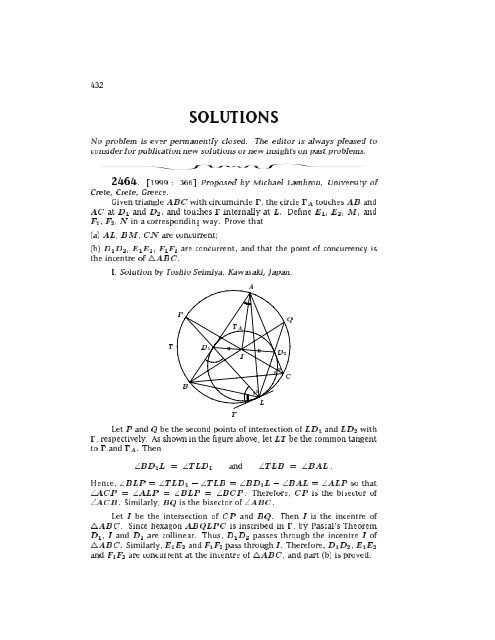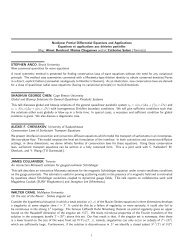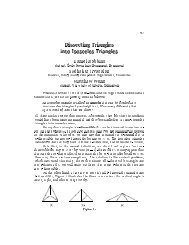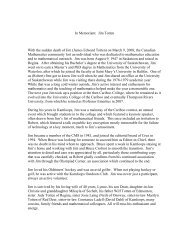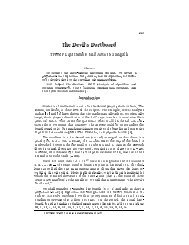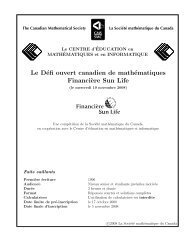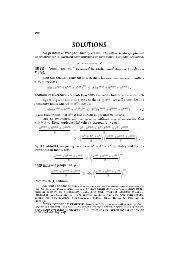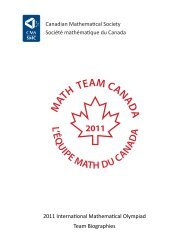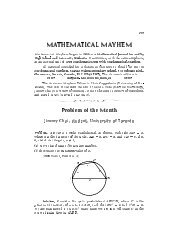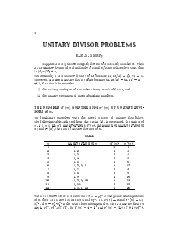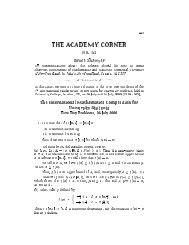Solutions: 2464, 2467, 2469, 2471--2476, 2478
Solutions: 2464, 2467, 2469, 2471--2476, 2478
Solutions: 2464, 2467, 2469, 2471--2476, 2478
Create successful ePaper yourself
Turn your PDF publications into a flip-book with our unique Google optimized e-Paper software.
432<br />
SOLUTIONS<br />
No problem is ever permanently closed. The editor is always pleased to<br />
consider for publication new solutions or new insightsonpastproblems.<br />
<strong>2464</strong>. [1999 : 366] Proposed by Michael Lambrou, University of<br />
Crete, Crete, Greece.<br />
Given triangle ABC with circumcircle ;, the circle ;A touches AB and<br />
AC at D1 and D2, and touches ; internally at L. De ne E1, E2, M, and<br />
F1, F2, N in a corresponding way. Prove that<br />
(a) AL, BM, CN are concurrent<br />
(b) D1D2, E1E2, F1F2 are concurrent, and that the point of concurrency is<br />
the incentre of4ABC.<br />
I. Solution by Toshio Seimiya, Kawasaki, Japan.<br />
;<br />
P<br />
B<br />
D1<br />
;A<br />
T<br />
Let P and Q be the second points of intersection of LD1 and LD2 with<br />
;, respectively. As shown in the gure above, let LT be the common tangent<br />
to ; and ;A. Then<br />
\BD1L = \TLD1 and \TLB = \BAL .<br />
Hence, \BLP = \TLD1 ; \TLB = \BD1L ; \BAL = \ALP so that<br />
\ACP = \ALP = \BLP = \BCP. Therefore, CP is the bisector of<br />
\ACB. Similarly, BQ is the bisector of \ABC.<br />
Let I be the intersection of CP and BQ. Then I is the incentre of<br />
4ABC. Since hexagon ABQLP C is inscribed in ;, byPascal's Theorem<br />
D1, I and D2 are collinear. Thus, D1D2 passes through the incentre I of<br />
4ABC. Similarly, E1E2 and F1F2 pass through I. Therefore, D1D2, E1E2<br />
and F1F2 are concurrent at the incentre of4ABC, and part (b) is proved.<br />
I<br />
A<br />
L<br />
D2<br />
Q<br />
C
433<br />
Since I is the incentre of4ABC, we have \D1AI = \D2AI. Since<br />
AD1 and AD2 are tangent to ;A, we have AD1 = AD2. Thus, D1I = D2I<br />
and AI ? D1D2. Since LD1 and LD2 are bisectors of\ALB and \ALC,<br />
respectively, we have<br />
Thus, we get<br />
Since 1<br />
2<br />
\BAC + 1<br />
2<br />
BL<br />
BD1<br />
\D2CI =90 , so that<br />
= AL<br />
AD1<br />
BL<br />
CL<br />
= AL<br />
AD2<br />
= CL<br />
.<br />
CD2<br />
BD1<br />
= . (1)<br />
CD2<br />
\ABC + 1<br />
2 \ACB =90 , we have \D1AI + \D1BI +<br />
\D1IB = \AD1I ; \D1BI = (90 ; \D1AI) ; \D1BI = \D2CI .<br />
Similarly, we have \D1BI = \D2IC. Hence, we have 4BD1I 4ID2C.<br />
Thus,<br />
Thus, we have<br />
BD1<br />
CD2<br />
From (1) and (2) we have<br />
B<br />
BD1<br />
ID2<br />
= ID1<br />
CD2<br />
= BD1<br />
ID2<br />
BL<br />
CL<br />
N<br />
ID1<br />
CD2<br />
= BI<br />
CI .<br />
= BI2<br />
. (2)<br />
CI2 BI2<br />
= . (3)<br />
CI2 Z<br />
I<br />
A<br />
X<br />
L<br />
Y<br />
M<br />
C
434<br />
Now let X be the intersection of AL with BC (see diagram above).<br />
Since \ABL + \ACL =180 , we have from (3)<br />
BX<br />
XC<br />
= [ABL]<br />
[ACL] =<br />
= AB<br />
AC<br />
BL<br />
CL<br />
1AB<br />
2<br />
1AC<br />
2<br />
BL sin \ABL<br />
CL sin\ACL<br />
=<br />
AB<br />
AC<br />
BI2 ,<br />
CI2 where [PQR] denotes the area of triangle PQR. Let Y and Z be the points<br />
of intersection of BM and CN with AC and AB, respectively. Then we can<br />
similarly show:<br />
Therefore,<br />
BX<br />
XC<br />
CY<br />
YA<br />
CY<br />
YA<br />
= BC<br />
BA<br />
AZ<br />
ZB<br />
CI 2<br />
AI 2<br />
= AB<br />
AC<br />
and<br />
BC<br />
BA<br />
CA<br />
CB<br />
AZ<br />
ZB<br />
BI 2<br />
CI 2<br />
= CA<br />
CB<br />
CI 2<br />
AI 2<br />
AI2 .<br />
BI2 AI2 = 1.<br />
BI2 By Ceva's Theorem AX, BY and CZ are concurrent. This implies that AL,<br />
BM and CN are concurrent.<br />
II. Solution by Nikolaos Dergiades, Thessaloniki, Greece.<br />
Let AB 0 C 0 be the symmetric triangle of triangle ABC relative to the<br />
bisector of angle A. Then both triangles have the same incircle and excircle<br />
in the angle A. LetIa be the centre of the excircle which touches AB at U,<br />
BC at L 00 , CA at T , and B 0 C 0 at L 0 .<br />
We apply inversion with pole A and power AB AC. The inverse point<br />
of B is C 0 and the inverse point of C is B 0 . The inverse of the circle ; is<br />
therefore the line B 0 C 0 and hence, since the circle ;A touches AB, AC and<br />
;, then its inverse is a circle that touches the sides of triangle AB 0 C 0 .(See<br />
gure on page 435.)<br />
If ;A wereoutside of ;, then its inverse would be the incircle of 4ABC,<br />
but now the inverse of ;A is the excircle in the angle A. Thus, the inverse of<br />
D1 is the point U, the inverse of D2 is the point T , and the inverse of L is<br />
the point L 0 .Since L 0 is the symmetric point of L 00 , it follows that AL is the<br />
isogonal line of AL 00 . But it is known (F.G.-M. 1242, 1242a Gergonne-like<br />
theorems) that AL 00 (and BM 00 and CN 00 , which correspond to the other<br />
angles of 4ABC) passes through Nagel's point. Thus, the isogonals AL,<br />
BM and CN are also concurrent.<br />
Now, AIa is the bisector of angle A and intersects D1D2 at J. The<br />
inverse of the line D1D2 is a circle which passes through A, U and T ,and<br />
since the points A, U, Ia, T areconcyclic, then the inverse of J is the point Ia.
Hence,<br />
I2<br />
T<br />
B 0<br />
U<br />
L L 0<br />
AJ AIa = AB AC =) AJ<br />
=)<br />
=<br />
AC<br />
4AJC<br />
AB<br />
AIa<br />
4ABIa<br />
=) \ACJ = \AIaB = C<br />
2 .<br />
;A<br />
B<br />
C<br />
L 00<br />
J<br />
D2<br />
C 0<br />
D1<br />
A<br />
435<br />
Thus, the point J is the incentre of4ABC, and D1D2, E1E2, F1F2<br />
are concurrent.<br />
Other consequences:<br />
1. It is obvious that if ;A were outside of ;, then the resultsare the same,<br />
but the point of concurrency would be the excentre instead of the<br />
incentre.<br />
2. The inverse of the circumcircles of 4ABD2 and 4ACD1 are the lines<br />
C 0 T and B 0 U,respectively (which are concurrent with AL 0 , F.G.-M.<br />
1242), and hence, these circumcircles intersect AL at a point that is the<br />
inverse of the symmetric of the adjoint of Gergonne's point of<br />
4ABC (F.G.-M. 1242).<br />
3. If r, r1, r2, r3 are the radii of the incircle and the excircles of 4ABC,<br />
s is the semiperimeter of 4ABC and R1, R2, R3 are theradii of<br />
;A, ;B, ;C, respectively, then since the power of A to the excircle is<br />
AT 2 = s 2 , then<br />
R1 = bc<br />
s2 r1 = bc<br />
s2 sr<br />
s ; a =<br />
r<br />
cos 2 (A=2) ,<br />
;
436<br />
and hence,<br />
R1 + R2 + R3 = r<br />
1<br />
cos2 (A=2) +<br />
1<br />
cos2 (B=2) +<br />
1<br />
cos2 (C=2)<br />
3r<br />
cos 2; (A + B + C)=6<br />
= 4r ,<br />
by Jensen's inequality, since the function f (x) =1= cos 2 x is convex.<br />
Also solved by MICHEL BATAILLE, Rouen, France CHRISTOPHER J. BRADLEY, Clifton<br />
College, Bristol, UK WALTHER JANOUS, Ursulinengymnasium, Innsbruck, Austria PETER<br />
Y. WOO, Biola University, La Mirada, CA, USA and the proposer.<br />
Janous observes that Banko (Mixtilinear Adventure, CRUX 9 (1983), pp. 2-7) has shown<br />
that the incentre I is even the mid-point of all three line segments he further mentions a<br />
forthcoming note byPaul Yiu (to appearintheAmerican Mathematical Monthly), entitled<br />
Mixtilinear Incircles, in which he shows that AL, BM and CN are concurrent at the external<br />
centre of similitude of the circumcircle and the incircle of 4ABC.<br />
<strong>2467</strong>. [1999 : 367] Proposed by Walther Janous, Ursulinengymnasium,<br />
Innsbruck, Austria.<br />
r<br />
s<br />
Given is a line segment UV and two<br />
rays, r and s, emanating from V such<br />
h<br />
that \(UVr) = \(rs) = 60 ,<br />
and two lines, g and h, onU such<br />
that \(UVg) = \(gh) = ,<br />
where 0 <
437<br />
In this case the locus is (part of) the internal bisector of \(rs). Thus,<br />
for the problem as given originally, the locus is (part of) the perpendicular to<br />
UV at V .<br />
Let A = h\r, B = g\r, C = g\s, D = h\s, and let P = AC\BD.<br />
Let VP meet the line h at E.<br />
r<br />
s<br />
A<br />
B<br />
E<br />
U V<br />
P<br />
C<br />
In triangle VADwe have from Ceva's Theorem:<br />
EA<br />
ED<br />
BV<br />
BA<br />
CD<br />
CV<br />
and from Menelaus' Theorem (relative to U, B, C):<br />
UA<br />
UD<br />
BV<br />
BA<br />
CD<br />
CV<br />
D<br />
h<br />
g<br />
= ;1 , (1)<br />
= 1. (2)<br />
From (1) and (2) we have<br />
UA EA<br />
= ;<br />
UD ED ,<br />
which means that the points U, E are harmonic conjugates to A, D. Since<br />
VU is the external bisector of \AV D, (that is, \(rs)), we conclude that<br />
VEis the internal bisector.<br />
Finally, as g turns so that \(UVg) runs from 0 until g is parallel to s<br />
and as h turns so that \(UVh) runs from 0 until h is parallel to r (as in<br />
the original problem), excepting the case when h is parallel to s, the point P<br />
sweeps the said bisector.<br />
Also solved by SEFKET ARSLANAGI C, University of Sarajevo, Sarajevo, Bosnia and<br />
Herzegovina CHRISTOPHER J. BRADLEY, Clifton College, Bristol, UK GERRY LEVERSHA,<br />
St. Paul's School, London, England TOSHIO SEIMIYA, Kawasaki, Japan D.J. SMEENK, Zaltbommel,<br />
the Netherlands and PETER Y. WOO, Biola University, La Mirada, CA, USA.<br />
<strong>2469</strong>. [1999:367]Proposed byPaul Yiu, Florida Atlantic University,<br />
Boca Raton, FL, USA.<br />
Given a triangle ABC, consider the altitude and the angle bisector at<br />
each vertex. Let PA be the intersection of the altitude from B and the bisector<br />
at C, andQA the intersection of the bisector at B and the altitude at C.
438<br />
These determine a line PAQA. The lines PBQB and PCQC are analogously<br />
de ned. Show that these three lines are concurrent at a point on the line<br />
joining the circumcentre and the incentre of triangle ABC. Characterize this<br />
point more precisely.<br />
[Ed. the solution is combined with that of the next problem.]<br />
2470. [1999:368]Proposed byPaul Yiu, Florida Atlantic University,<br />
Boca Raton, FL, USA.<br />
Given a triangle ABC, consider the median and the angle bisector at<br />
each vertex. Let PA be the intersection of the median from B and the bisector<br />
at C,andQA the intersection of the bisector at B and the median at C. These<br />
determine a line PAQA. The lines PBQB and PCQC are analogously de ned.<br />
Show that these three lines are concurrent. Characterize this intersection<br />
more precisely.<br />
Combined generalization of <strong>2469</strong> and 2470 devised independently by<br />
Nikolaos Dergiades, Thessaloniki, Greece and by Peter Y. Woo, Biola University,<br />
La Mirada, CA, USA.<br />
Given 4ABC, its incentre I, and a point X not on the sides of the<br />
triangle, de ne<br />
PA = BX T CI PB = CX T AI PC = AX T BI<br />
Qa = BI T CX QB = CI T AX QC = AI T BX ,<br />
and prove that<br />
(i) PAQA, PBQB, PCQC are concurrent at a point S, and<br />
(ii) S lies on the line joining I to the isogonal conjugate ofX.<br />
Solution to (i) byPeter Y. Woo, Biola University, La Mirada, CA, USA.<br />
The concurrency is an immediateconsequenceofPappus' theorem: QA,<br />
PB, X are three points on the line CX whileTQB, PA, I are three points T on<br />
CI. The cross-joins intersect at S = PAQA QBPB, PC = IQA QBX,<br />
and QC = PAX T IPB, whose collinearity implies that S is on the axis<br />
PCQC, which proves (i).<br />
Editor's comment. Note the appropriateness of an alternative statement<br />
of Pappus' theorem | \If two triangles are doubly perspective, they<br />
are triply perspective." Here wearegiven that the triangles of P -pointsand<br />
of Q-pointsare perspective from both I and X, so our conclusion is that they<br />
are perspective from a third point S.<br />
Solution to (ii) by Michel Bataille, Rouen, France (whose separate solutions<br />
to <strong>2469</strong> and 2470 have been combined by the editor).<br />
We shall use trilinear coordinates relative to 4ABC with A(1 0 0),<br />
B(0 1 0), C(0 0 1) and I(1 1 1). Let the coordinates of the given point<br />
X be (1=u 1=v 1=w) so that its isogonal conjugate is the point X 0 (u v w).<br />
Let PA have the unknown coordinates (x y z) that we want to evaluate in<br />
terms of the given u, v and w.
PA is on BX so that det<br />
PA is on CI so that det<br />
0<br />
B<br />
@<br />
0<br />
@<br />
x 0<br />
y 1<br />
z 0<br />
x 0 1<br />
y 0 1<br />
z 1 1<br />
1<br />
u<br />
1<br />
v<br />
1<br />
w<br />
1<br />
C<br />
A = 0, which gives x<br />
w<br />
1<br />
A = 0, which gives y = x.<br />
439<br />
= z<br />
u .<br />
From this we get PA(w w u) and, by suitable permutations, QA(vu v),<br />
PB(v u u), QB(w w v), PC(vw v) and QC(w u u). By adding PA to<br />
QA, and so forth, we see that PAQA, PBQB, PCQC concur at the point S<br />
that satis es<br />
S = (v + w w + u u + v) .<br />
By adding the coordinates of S to X 0 (u v w) we see that S, X 0 and the<br />
incentre I(1 1 1) are collinear, as desired.<br />
In <strong>2469</strong> we are given that X is the orthocentre H(sec A sec B sec C) its<br />
isogonal conjugate is the circumcentre X 0 (u v w) =O(cos A cos B cos C).<br />
Here S is the point on IO with coordinates (cos B +cosC cos C + cos A<br />
cos A +cosB) this point is X65 in Kimberling's list [Ed. Clark Kimberling,<br />
Central Points and Central Lines in the Plane of a Triangle, Math. Mag. 67:3<br />
(June 1994) 163-187. Alternatively, one can consult his web page:<br />
http://cedar.evansville.edu/ ck6/encyclopedia/].<br />
Editor's comments. Janous and Yiu both show that I lies between O<br />
and S and divides that segment in the ratio R : r. Most solvers noted that<br />
S is the isogonal conjugate of the Schi er point (X21 in Kimberling's list),<br />
which Kimberling named for the proposerofproblem 1018 [1986: 150-152].<br />
In 2470 we are given X = G (1=a 1=b 1=c) whose isogonal conjugate<br />
is the Lemoine point L(a b c). Here S = (b + c c + a a + b), which is<br />
\the simplest unnamed centre" X37 in Kimberling's list.<br />
[Comment. Janous and Yiu show instead that the centroid G lies between<br />
S and the isotomic conjugate of the incentre, and it divides that segment<br />
in the ratio 1:2. This fact also appears in Kimberling's table 3.]<br />
Both problems were also solved by CHRISTOPHER J. BRADLEY, Clifton College, Bristol,<br />
UK NIKOLAOS DERGIADES, Thessaloniki, Greece WALTHER JANOUS, Ursulinengymnasium,<br />
Innsbruck, Austria TOSHIO SEIMIYA, Kawasaki, Japan and the proposer.
440<br />
<strong>2471</strong>. [1999 : 368] Proposed by Vedula N. Murty, Dover, PA, USA.<br />
For all integers n 1, determine the value of<br />
nX<br />
k=1<br />
(;1) k;1 k<br />
k +1<br />
n +1<br />
k<br />
Solution by Heinz-Jurgen Sei ert, Berlin, Germany.<br />
Let Sn, n 1, be the sum in question. It is straightforward to check<br />
that the equality<br />
k<br />
k +1<br />
n +1<br />
k<br />
=<br />
n +1<br />
k<br />
; 1<br />
n +2<br />
n +2<br />
k +1<br />
holds for k = 1, 2, :::, n. Applying the above equality and the Binomial<br />
Theorem, we nd<br />
Sn =<br />
nX<br />
k=1<br />
k;1 n +1<br />
(;1)<br />
k<br />
; 1<br />
n +2<br />
nX<br />
k=1<br />
k;1 n +2<br />
(;1)<br />
k +1<br />
= ;(1 ; 1) n+1 +1; (;1) n<br />
; n+2 n<br />
(1 ; 1) ; 1+(n +2); (;1)<br />
; 1<br />
n +2<br />
= 1 ; (;1)n (n +1)<br />
n +2<br />
.<br />
Also solved by SEFKET ARSLANAGI C, University of Sarajevo, Sarajevo, Bosnia and<br />
Herzegovina MICHEL BATAILLE, Rouen, France CHRISTOPHER J. BRADLEY, Clifton College,<br />
Bristol, UK JAMES T. BRUENING, Southeast Missouri State University, Cape Girardeau, MO,<br />
USA NIKOLAOS DERGIADES, Thessaloniki, Greece JOSE LUIS DIAZ, Universitat Politecnica<br />
de Catalunya, Terrassa, Spain CHARLES R. DIMINNIE, Angelo State University, San Angelo,<br />
TX, USA DAVID DOSTER, Choate Rosemary Hall, Wallingford, CT, USA RUSSELL EULER and<br />
JAWAD SADEK, NW Missouri State University, Maryville, MO, USA RICHARD I. HESS, Rancho<br />
Palos Verdes, CA, USA PETER HURTHIG, Columbia College, Vancouver, BC WALTHER<br />
JANOUS, Ursulinengymnasium, Innsbruck, Austria MURRAY S. KLAMKIN, University ofAlberta,<br />
Edmonton, Alberta MICHAEL LAMBROU, University ofCrete, Crete, Greece KEE-WAI<br />
LAU, Hong Kong HO-JOO LEE, student, Kwangwoon University, Kangwon-Do, South Korea<br />
DIGBY SMITH, Mount Royal College, Calgary, Alberta EDWARD T.H. WANG, Wilfrid Laurier<br />
University, Waterloo, Ontario and the proposer.<br />
2472. [1999 : 368] Proposed by Vaclav Konecny, Ferris State University,<br />
Big Rapids, MI, USA.<br />
If A, B, C are the angles of a triangle, prove that<br />
cos 2<br />
A ; B<br />
2<br />
cos 2<br />
B ; C<br />
2<br />
8 sin A<br />
2<br />
cos 2<br />
sin B<br />
2<br />
C ; A<br />
2<br />
sin C<br />
2<br />
3<br />
.<br />
.
441<br />
I. Editorial comment.<br />
As some solvers pointed out, this follows immediately from<br />
problem 2382 [1999 : 440]. In fact, in [1999 : 441], it is given that<br />
cos 2<br />
B ; C<br />
2<br />
8sin A<br />
2<br />
sin B<br />
2<br />
sin C<br />
2<br />
(= 2r<br />
) ,<br />
R<br />
and, bysymmetry, the same is true for cos 2 [(A;B)=2] and cos 2 [(C;A)=2],<br />
and so we are done.<br />
cos<br />
II. Solution by Heinz-Jurgen Sei ert, Berlin, Germany.<br />
In CRUX 585 [1981 : 303] it was shown that<br />
A ; B<br />
2<br />
cos<br />
B ; C<br />
2<br />
cos<br />
C ; A<br />
2<br />
8sin A<br />
2<br />
sin B<br />
2<br />
sin C<br />
2<br />
. (1)<br />
By squaring (1) and multiplying the right hand side of the resulting inequality<br />
by 8 sin(A=2) sin(B=2) sin(C=2), whichis 1 (see O. Bottema et al,<br />
Geometric Inequalities, item 2.12), the desired inequality follows.<br />
Also solved by SEFKET ARSLANAGI C, University of Sarajevo, Sarajevo, Bosnia and<br />
Herzegovina (two solutions) MICHEL BATAILLE, Rouen, France NIKOLAOS DERGIADES,<br />
Thessaloniki, Greece RICHARD I. HESS, Rancho Palos Verdes, CA, USA WALTHER JANOUS,<br />
Ursulinengymnasium, Innsbruck, Austria MICHAEL LAMBROU, University ofCrete, Crete,<br />
Greece KEE-WAI LAU, Hong Kong HO-JOO LEE, student, Kwangwoon University, Kangwon-<br />
Do, South Korea D.J. SMEENK, Zaltbommel, the Netherlands ECKARD SPECHT, Otto-von-<br />
Guericke University, Magdeburg, Germany PANOS E. TSAOUSSOGLOU, Athens, Greece and<br />
the proposer.<br />
Dergiades and Lambrou also derive the stronger inequality (1), though without referring<br />
to CRUX 585 to do it. Janous<br />
Y B ; C<br />
cos<br />
2<br />
nds the even stronger inequality<br />
9 ; 8 Y sin A Y A<br />
sin<br />
2<br />
2<br />
8 Y sin A<br />
2 .<br />
In the other direction, Janous also proves<br />
Y<br />
cos<br />
B ; C<br />
2<br />
1<br />
2 +3Y sin A<br />
2 +8 Y sin A<br />
2<br />
2<br />
.<br />
Lambrou further connected this problem to another earlier CRUX problem, as follows.<br />
Put A = ; 2A1, etc. then A1, B1, C1 are the angles of an acute triangle, and (1) becomes<br />
Y cos(B1 ; A1) 8<br />
Y cos A1 .<br />
Rewriting A1 as A, etc., we get that (1), over all triangles, is equivalent to the inequality<br />
Y Y<br />
cos(B ; A) 8 cos A (2)<br />
over all acute triangles. Now let O be the circumcentre of triangle ABC, letAO meet the<br />
circle BOC again at A 0 , and de ne B 0 and C 0 similarly. Then the radius R1 of circle BOC<br />
satis es<br />
R1 =<br />
R<br />
2cosA :<br />
Letting O1 be the centre ofcircle BOC,we ndthat\O1OA 0 = B ; C, so<br />
OA0 R cos(B ; C)<br />
=2R1 cos(B ; C) =<br />
cos A<br />
and cyclically for OB0 and OC0 . Thus (2) is equivalent to<br />
OA0 OB0 OC0 8R3 which is unused problem 13 from the 1996 IMO see [1999 : 8] for a solution.
442<br />
2473. [1999 : 368] Proposed by Miguel Amengual Covas, Cala<br />
Figuera, Mallorca, Spain.<br />
Given a point S on the side AC of triangle ABC, construct a line<br />
through S which cuts lines BC and AB at P and Q, respectively, such that<br />
PQ = PA.<br />
Solution by D.J. Smeenk, Zaltbommel, the Netherlands.<br />
Let D be the re ection of A in BC, so that 4DBC is congruent to<br />
4ABC.<br />
Let the line through S parallel to AB intersect BD at T . Let the circumcircle<br />
of 4STD intersect BC at P1 and P2. LetSP1 and SP2 intersect<br />
AB and Q1 and Q2, respectively.<br />
Then P1Q1 = P1A and P2Q2 = P2A.<br />
P2<br />
S<br />
C<br />
r<br />
O<br />
P1<br />
A Q2 B Q1<br />
Proof. Note that BC is an axis of symmetry of quadrilaterals<br />
T<br />
ABCD , ABDP1 , and ABDP2 . (1)<br />
Since quadrilateral SP1TD is cyclic, we have<br />
\P1ST = \P1DT = , say. (2)<br />
Now, (1) and (2) imply that \P1AB = \P1DB = . Since STkAB, we<br />
have<br />
\P1Q1A = \P1ST = . (3)<br />
D
Now, (2) and (3) imply that P1Q1 = P1A.<br />
From (1), we obtain that<br />
Since quadrilateral P2STD is cyclic, we have<br />
443<br />
\P2AB = \P2DB . (4)<br />
\P2ST = \P2Q2B = 180 ; \P2AB . (5)<br />
Now, (4) and (5) imply that \P2AQ2 = \P2Q2A, so that P2Q2 = P2A.<br />
Also solved by MICHEL BATAILLE, Rouen, France NIELS BEJLEGAARD, Stavanger,<br />
Norway NIKOLAOS DERGIADES, Thessaloniki, Greece WALTHER JANOUS, Ursulinengymnasium,<br />
Innsbruck, Austria MICHAEL LAMBROU, University ofCrete, Crete, Greece TOSHIO<br />
SEIMIYA, Kawasaki, Japan PETER Y. WOO, Biola University, La Mirada, CA, USA and the<br />
proposer.<br />
Smeenk commented that he found it to beavery interesting problem on which he spent<br />
much time, but found only a quadratic equation with unknown tan , which was quite unsatisfactory.<br />
He then asked a friend, who asked another friend, who found this elegant solution in<br />
an old issue of Euclides, a Dutch mathematical periodical.<br />
Bataille, Bejlegaard and Lambrou all made reference topartofthisproblem being a<br />
well-known classical problem. Bataille refered to H. Dorrie, 100Great Problems of Elementary<br />
Geometry, Dover, 1965, and Lambrou, to B. Bold, Famous Problems of Geometry, also<br />
published by Dover.<br />
2474 ? . [1999 : 368] Proposed by Mohammed Aassila, CRM, Universite<br />
de Montreal, Montreal, Quebec.<br />
Let f : R + ! R + be a decreasing continuous function satisfying, for<br />
all x, y 2 R + :<br />
f (x + y)+f ; f (x) +f (y) = f f ; x + f (y) + f ; y + f (x) .<br />
Obviously f (x) =c=x (c >0) is a solution. Determine all other solutions.<br />
Editor's remark: This problem should have been starred when posed,<br />
since it was proposed without a solution.<br />
Comment by proposer: One can prove that if f satis es the functional<br />
equation, then f (f (x)) = x for all x 2 R + (this was problem 5 of the 1997<br />
Iranian Mathematical Olympiad), but determining all the solutions seems to<br />
be a very challenging problem.<br />
This problem remains open.
444<br />
2475. [1999 : 368] Proposed by Joaqu n Gomez Rey, IES Luis Bu ~nuel,<br />
Alcorcon, Spain.<br />
Prove that<br />
nX<br />
nX<br />
j=0 k=1<br />
j+k 2n<br />
(;1)<br />
2j<br />
2n<br />
2k ; 1<br />
= 0.<br />
I. Solution by David Doster, Choate Rosemary Hall, Wallingford, CT,<br />
USA.<br />
Then nP<br />
Let An =<br />
j=0<br />
nP<br />
nP<br />
(;1)<br />
j=0<br />
j ; 2n<br />
(;1)<br />
k=1<br />
j+k; 2n<br />
2j<br />
2j and Bn =<br />
nP<br />
(;1)<br />
k=1<br />
k; 2n<br />
2k;1 .<br />
; 2n<br />
2k;1 = AnBn and (1 + i) 2n = An ; iBn.<br />
Thus, (;4) n =(2i) 2n = ; (1 + i) 2 2n =(1+i) 4n =(A2 n ; B2 n ) ; 2iAnBn,<br />
from which we infer that A2 n ; B2 n =(;4)n and AnBn =0.<br />
nX<br />
j=0<br />
II. Solution by GerryLeversha, St. Paul's School, London, England.<br />
It is su cient to note that the given expression factorizes:<br />
nX<br />
k=1<br />
j+k 2n<br />
(;1)<br />
2j<br />
2n<br />
2k ; 1 =<br />
0<br />
@ nX<br />
j=0<br />
(;1)<br />
j 2n<br />
2j<br />
1<br />
A<br />
nX<br />
k=1<br />
(;1) k<br />
2n<br />
2k ; 1<br />
and then to note that, by the symmetry ofPascal's triangle, the rst bracket<br />
on the right side is zero for odd values of n and the second bracket is zero for<br />
even values of n.<br />
Also solved by SEFKET ARSLANAGI C, University of Sarajevo, Sarajevo, Bosnia and<br />
Herzegovina MICHEL BATAILLE, Rouen, France CHRISTOPHER J. BRADLEY, Clifton College,<br />
Bristol, UK JAMES T. BRUENING, Southeast Missouri State University, Cape Girardeau, MO,<br />
USA NIKOLAOS DERGIADES, Thessaloniki, Greece CHARLES R. DIMINNIE, Angelo State<br />
University, San Angelo, TX, USA RICHARD I. HESS, Rancho Palos Verdes, CA, USA WALTHER<br />
JANOUS, Ursulinengymnasium, Innsbruck, Austria MURRAY S. KLAMKIN, University ofAlberta,<br />
Edmonton, Alberta MICHAEL LAMBROU, University ofCrete, Crete, Greece KEE-WAI<br />
LAU, Hong Kong HEINZ-JURGEN SEIFFERT, Berlin, Germany DIGBY SMITH, Mount Royal<br />
College, Calgary, Alberta CHOONGYUP SUNG, Pusan Science High School, Pusan, Korea<br />
EDWARD T.H. WANG, Wilfrid Laurier University, Waterloo, Ontario PETER Y. WOO, Biola<br />
University, La Mirada, CA, USA JEREMY YOUNG, student, Nottingham High School, Nottingham,<br />
UK and the proposer.<br />
All the submitted solutions are minor variations of either I or II above, with the only<br />
exception of that by the proposer, which uses De Moivre's formula.<br />
!
445<br />
<strong>2476</strong> ? . [1999 : 429] Proposed by Mohammed Aassila, CRM, Universite<br />
de Montreal, Montreal, Quebec.<br />
Let n be a positive integer and consider the set f1, 2, 3, :::, 2ng. Give<br />
a combinatorial proof that the number of subsets A such that<br />
1. A has exactly n elements, and<br />
2. the sum of all elements inA is divisible by n,<br />
is equal to<br />
1<br />
n<br />
X<br />
djn<br />
(;1)<br />
n+d 2d<br />
d<br />
where is the Euler function. [Ed. Note the correction in the line above.]<br />
Note: When n is prime, proving the formula is problem 6 of the 1995<br />
IMO. A non-combinatorial proof of the formula is due toRoberto Dvornicich<br />
and Nikolay Nikolov.<br />
Editor's remark: This problem should have been starred when posed,<br />
since it was proposed without a solution.<br />
This problem remains open.<br />
<strong>2478</strong>. [1999 : 429] Proposed by Joaqu n Gomez Rey, IES Luis Bu ~nuel,<br />
Alcorcon, Spain.<br />
nX n ; k<br />
For n 2 N, evaluate<br />
k +1<br />
2k<br />
k<br />
2n ; 2k<br />
n ; k<br />
.<br />
k=0<br />
Solution by Walther Janous, Ursulinengymnasium, Innsbruck, Austria<br />
(adapted by the editor).<br />
[Ed: This solution assumes familiarity with Newton's generalized<br />
binomial coe cients together with some identities thereof.]<br />
; n<br />
d<br />
Let Sn denote the summation to beevaluated.<br />
The following formulas regarding generalized binomial coe cients are<br />
known and easy toverify:<br />
nX<br />
k=0<br />
1<br />
k ; 2<br />
(;4)<br />
l<br />
k<br />
k<br />
;1<br />
n<br />
m<br />
k +1<br />
m<br />
n ; k<br />
=<br />
2k<br />
k<br />
,<br />
, (1)<br />
= (;1) n , (2)<br />
= m<br />
k +1<br />
= l + m<br />
n<br />
m ; 1<br />
k<br />
, (3)<br />
. (4)
446<br />
[Ed: In all formulas, l and m denote arbitrary integers and n and k,<br />
non-negative integers. Formula (4) is usually referred to as the Vandermonde's<br />
Convolution Formula.]<br />
Using (3) with m = 1<br />
2<br />
and<br />
Therefore, we have<br />
Sn =<br />
n;1 X<br />
k=0<br />
n ; k<br />
k +1<br />
X<br />
= (;4) n<br />
n;1<br />
2<br />
k=0<br />
1<br />
2<br />
k +1<br />
; 1<br />
2<br />
n ; k<br />
= ;(;4) n<br />
n;1<br />
= ;(;4) n<br />
= ;(;4) n<br />
= ;4 n +<br />
1 and ; ,respectively, we obtain<br />
2<br />
=<br />
=<br />
(;4)k ; 1<br />
2<br />
k<br />
X<br />
k=0<br />
1<br />
2<br />
k +1<br />
1<br />
2<br />
k +1<br />
;1<br />
n ;<br />
1<br />
2(k +1)<br />
;1<br />
2(n ; k)<br />
(;4) n;k<br />
(; 1<br />
2 )<br />
1<br />
2<br />
0<br />
; 1<br />
2<br />
k<br />
; 3<br />
2<br />
n ; k ; 1<br />
1 ; 2<br />
n ; k<br />
; 3<br />
2<br />
n ; k ; 1<br />
; 3<br />
2<br />
n ; k ; 1<br />
; 3<br />
2<br />
n<br />
(;1) n +2(n +1)<br />
n +1<br />
2<br />
2n +2<br />
n +1<br />
= (2n +1) 2n<br />
n ; 4n .<br />
!<br />
; 1<br />
2<br />
n +1<br />
!<br />
(5)<br />
. (6)<br />
(by (1))<br />
(by (5), (6))<br />
(by (4))<br />
(by (2), (6))<br />
(by (1))<br />
Also solved by MICHEL BATAILLE, Rouen, France PAUL BRACKEN, CRM, Universitede<br />
Montreal, Montreal, Quebec G.P. HENDERSON, Garden Hill, Campbellcroft, Ontario HEINZ-<br />
JURGEN SEIFFERT, Berlin, Germany SOUTHWEST MISSOURI STATE UNIVERSITY PROBLEM<br />
SOLVING GROUP, Spring eld, MO, USA and the proposer.<br />
Most of the other submitted solutions involve di erentiation and integration of the<br />
power series expansion of the function f(x) =(1; 4x) ; 1 2 for j x j< 1 4 .
447<br />
2479. [1999 : 430] Proposed by Joaqu n Gomez Rey, IES Luis Bu ~nuel,<br />
Alcorcon, Spain.<br />
Writing (n) for the number of divisorsofn, and !(n) for the number<br />
of distinct prime factors ofn, prove that<br />
nX<br />
k=1<br />
( (k)) 2 =<br />
nX<br />
k=1<br />
2 !(k)<br />
bn=kc X<br />
j=1<br />
bn=kc<br />
j<br />
Solution by Heinz-Jurgen Sei ert, Berlin, Germany. If n k 2 N, then<br />
there exist m 2 N0 and r 2f0 1:::k; 1g such that n ; 1=km + r.<br />
Then<br />
Hence,<br />
n<br />
k<br />
= m + r +1<br />
k<br />
n<br />
k<br />
; n ; 1<br />
k<br />
=<br />
and<br />
( 1 if kjn.<br />
n ; 1<br />
k<br />
0 otherwise.<br />
.<br />
= m .<br />
Let Sn, n 2 N0, denote the sum on the right hand side of the desired<br />
equation (empty sums are understood to be0). If n 2 N, then from the<br />
above result we have<br />
Sn ; Sn;1 =<br />
X<br />
kjn<br />
2 !(k)<br />
bn=kc X<br />
j=1<br />
or, by applying the result once again,<br />
Sn ; Sn;1 =<br />
X<br />
kjn<br />
bn=kc<br />
j<br />
2 !(k)<br />
; b(n ; 1)=kc<br />
n<br />
k<br />
j<br />
With the notation of Dirichlet products (see, for example, T.M. Apostol, Introduction<br />
to Analytic Number Theory, 2nd Ed., Springer, 1984, 29-39), the<br />
latter equation may be written as Sn;Sn;1 =(f )(n), n 2 N, where the<br />
arithmetical function f is de ned by f (n) =2 !(n) , n 2 N. We claim that<br />
f = 2 (where 2 means ordinary pointwise multiplication). Since f, ,<br />
and 2 are all multiplicative, it su ces to show that (f )(p e )=( (p e )) 2<br />
when p is a prime and e 2 N. We have<br />
(f )(p e ) = ( f )(p e ) =<br />
= (p e )+2<br />
e;1 X<br />
j=0<br />
eX<br />
j=0<br />
= (e +1) 2 = ( (p e )) 2 .<br />
.<br />
(p j )f (p e;j )<br />
X<br />
(pj e;1<br />
) = (e +1)+2 (j +1)<br />
j=0<br />
,
448<br />
It follows that Sn ; Sn;1 =( (n)) 2 for all n 2 N. Replacing n by k and<br />
summing over k =1, 2, :::, n, n 2 N, gives the requested equation.<br />
Also solved by MICHEL BATAILLE, Rouen, France WALTHER JANOUS, Ursulinengymnasium,<br />
Innsbruck, Austria KEE-WAI LAU, Hong Kong and the proposer.<br />
Janous observes that the identity<br />
( (n)) 2 = X<br />
2 !(k)<br />
kjn<br />
(implied in the above proof, but not explicitly stated) may be new and is worth noting in its<br />
own right, and that applying the Mobius inversion formula to it yields another identity which<br />
may be new: X<br />
2 !(k) =<br />
kjn<br />
X<br />
kjn<br />
n<br />
k<br />
(k) 2 n<br />
k<br />
Crux Mathematicorum<br />
Founding Editors /Redacteurs-fondateurs: Leopold Sauve&Frederick G.B. Maskell<br />
Editors emeriti / Redacteur-emeriti: G.W. Sands, R.E. Woodrow, Bruce L.R. Shawyer<br />
Mathematical Mayhem<br />
Founding Editors /Redacteurs-fondateurs: Patrick Surry &Ravi Vakil<br />
Editors emeriti / Redacteurs-emeriti: Philip Jong, Je Higham,<br />
J.P. Grossman, Andre Chang, Naoki Sato, Cyrus Hsia


